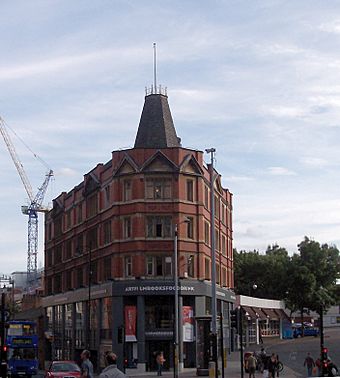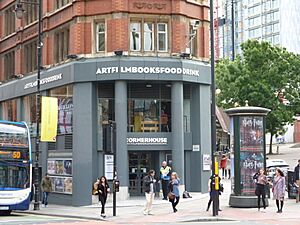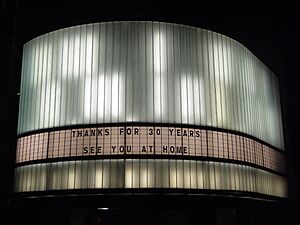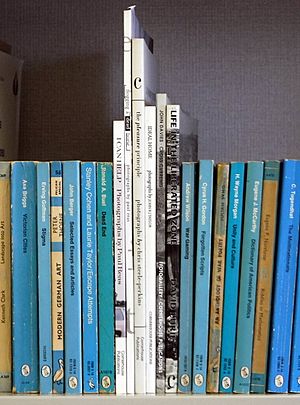Cornerhouse facts for kids
 |
|
| Location | Oxford Street, Manchester, England |
|---|---|
| Coordinates | 53°28′27.50″N 2°14′28″W / 53.4743056°N 2.24111°W |
| Opened | 1985 |
| Closed | 2015 |
Cornerhouse was a cool place in Manchester, England. It was a special centre for movies and modern art. From 1985 to 2015, it stood right next to Oxford Road Station. Inside, you could find three floors of art galleries and three movie screens. There was also a bookshop, a bar, and a café. A group called Greater Manchester Arts Centre Ltd, which was a charity, ran Cornerhouse.
Contents
The Buildings of Cornerhouse
Cornerhouse was actually made up of two different buildings. The main building, at 70 Oxford Street, was built in the early 1900s. It used to be a furniture shop owned by the John Shaw family. That shop closed down in 1985.
The other building was on the opposite side of the path to Oxford Road station. It was designed by Peter Cummings and finished in 1934. This building first opened as a cinema called Tatler News Theatre in May 1935. Over the years, the cinema changed its name many times. It was known as Essoldo, Tatler Classic, and Tatler Cinema Club before it closed in 1981.
A Look Back: Cornerhouse's Story
The idea for Cornerhouse came from a group called the Greater Manchester Visual Arts Trust. Sir Bob Scott was in charge of this group. Cornerhouse opened with help from local councils and arts organisations. These included the Greater Manchester County Council and Manchester City Council.
The first director of Cornerhouse was Dewi Lewis. He had worked at another arts centre before. The building officially opened its doors on October 3, 1985. The very first movie shown there was Insignificance on October 18. Later, Dave Moutrey became the director and CEO in 1998. He led Cornerhouse until 2024.
Cornerhouse was known for showing important films and art. It hosted the first UK showing of Quentin Tarantino's movie Reservoir Dogs. It was also the first public art gallery in the UK to ask artist Damien Hirst to create new work.
In 2012, it was announced that Cornerhouse would join with another group. This group was the Library Theatre Company. Together, they formed a new arts centre called HOME. In 2015, both organisations moved to their new building, the HOME centre.
After Cornerhouse closed, its cinema building was used by a group called the Loose Space Collective for a few months in 2017.
What Could You Do There?
Cornerhouse offered a mix of independent movies and modern art. Its art galleries focused on showing artists who were not yet widely known in Britain. It also helped more experienced artists create new projects. These projects were shown both at Cornerhouse and in other places.
The visual arts programme showed art in many forms. It often featured films and videos that connected with the movie programme. Cornerhouse created or helped create all of its art exhibitions. It also made a special guide for each show.
A regular part of its art programme was international group exhibitions. These shows often looked at social and political issues. In 2011, Cornerhouse started a project called Artist Film. This project helped produce and share longer films. The first film was Self Made by Gillian Wearing.
The cinemas at Cornerhouse showed about 30 different movies every month. The cinemas were open seven days a week. They had daily shows in the afternoon and evening. This meant almost 3,500 movie showings each year.
Cornerhouse's film programme showed movies from all over the world. It featured new and exciting films, as well as older ones. You could see movies that were overlooked or underrated. They also showed classic films, short films, cartoons, and documentaries. Sometimes, they even showed avant-garde films and foreign language movies. Cornerhouse also ran two film festivals every year: ¡Viva! Spanish and Latin American Film Festival, and exposures.
Books Published by Cornerhouse
In 1987, Dewi Lewis started a publishing part of Cornerhouse called Cornerhouse Publications. Their first book was A Green and Pleasant Land by John Davies. Cornerhouse Publications won an award in 1990. It was named joint winner of The Sunday Times Small Publisher of The Year Award. This publishing group kept going until 1994. During that time, they published books by many important photographers from around the world.




